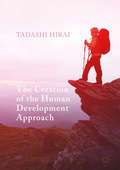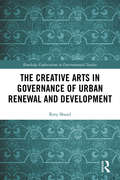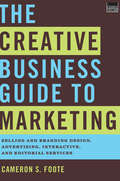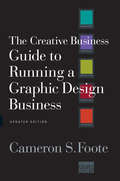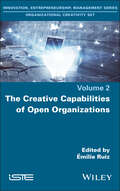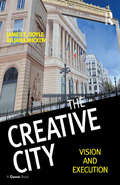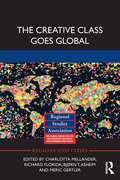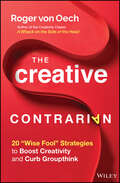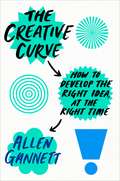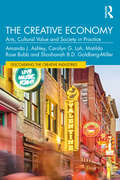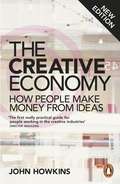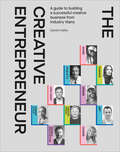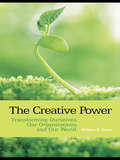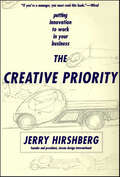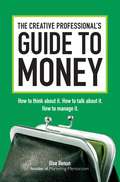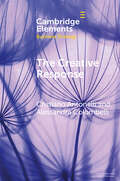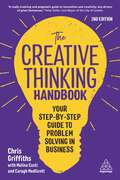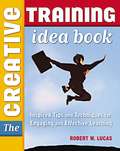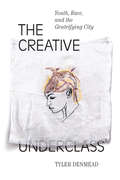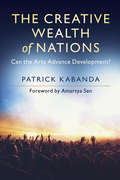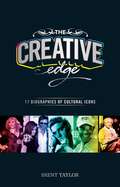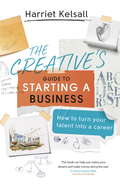- Table View
- List View
The Creation of the Human Development Approach
by Tadashi HiraiThis book examines the main reasons and challenges for the success of the human development approach both in theory and practice as an alternative to the economic growth model. Unlike the preceding research which has typically been either theoretical/prescriptive or empirical/descriptive, it follows a pragmatic historical and institutional methodology, since human development cannot be understood without considering the complexities added centrally by the formation process in the UNDP. Referring to the capability approach, it also addresses how to best reflect happiness within this paradigm.
The Creative Arts in Governance of Urban Renewal and Development (Routledge Explorations in Environmental Studies)
by Rory ShandThis book focuses on the role of the creative sector in the governance of urban renewal and economic development initiatives. Rory Shand examines the ways in which both the top-down nature of the creative sector, and the bottom-up roles of creative arts organisations, drive development and engage with local communities or areas in regeneration projects that target employment, training and education, as well as social engagement. Underpinning these projects are governance mechanisms, through delivery, funding and participation. Drawing on case studies from the UK, Germany and Canada, Shand compares national creative sector policies and creative arts bodies engaged in the governance of urban renewal and development programmes, as well as including a comparative chapter offering an overview of best and worst practice, which also examines and summarises the key themes across both theory and practice. In his concluding remarks, he highlights and discusses the key challenges posed by governance mechanisms to urban renewal and economic development programmes and identifies future comparative case studies in the field. This book will be of great interest to students of environmental studies, public policy and politics and geography, as well as being a relevant resource for practitioners from NGOs, local and national levels of governments and community projects.
The Creative Business Guide to Marketing: Selling And Branding Design, Advertising, Interactive, And Editorial Services
by Cameron S. FooteThe go-to guide on how to market a creative organization, why it is important, and what techniques work. Marketing influences the success of creative services businesses more than any other issue: bad luck, insufficient funding, difficult clients, and weak employees all pale by comparison. Old standbys—word of mouth, referrals, and occasional promotions—are inadequate in today's competitive environment. Whether focused on design, advertising, interactive, editorial, or public relations, all creatives need this know-how book for marketing their business.
The Creative Business Guide to Running a Graphic Design Business (Revised)
by Cameron S. FooteThe go-to guide for graphic designers who want to run their own shop and improve their bottom line. First published in 2001, The Creative Business Guide to Running a Graphic Design Business set long-needed standards as the first comprehensive management manual for the graphic design industry. Now brought up-to-date, it describes current, best-practice procedures for firms of all sizes operating in an industry that is both fast-evolving and increasingly competitive.
The Creative Capabilities of Open Organizations
by Émilie RuizCreativity has become a major issue for organizations and their managers alike. While it is acknowledged that creative capability exists within organizations, we tend to focus solely on what fosters it, thus neglecting creativity in contexts of openness. With the help of numerous case studies from open organizations, The Creative Capabilities of Open Organizations analyzes the way in which creative capabilities are developed. The book puts into perspective the abundant but solid literature on the creative capability of particularly exciting and instructive industries, such as the outdoor sports industry, the music industry, and the video game industry. It holistically treats openness, going beyond a purely external view by analyzing cases illustrating intra-organizational openness.
The Creative City: Vision and Execution
by James E. Doyle Biljana MickovThe Creative City: Vision and Execution, edited by James E. Doyle and Biljana Mickov, challenges the popular understanding of the Creative City, by bridging the gap between the Creative City as concept and the Creative City as practice and, in so doing, provides a contemporary template for policy makers, city planners, and citizens alike. The book will offer researchers and pragmatists a series of real-life examples of successful cultural and creative practice throughout Europe, reflecting on the analysis and thinking that forms our contemporary understanding of the creative city. It will examine and explain the changes to the concept of the ’creative city’, explore its connectivity to the cultural sector as well as other sectors and practices across Europe and will serve to illustrate the perspectives of Cultural Managers, Educators, Professionals and Researchers from the creative sector in Dublin and Europe. This book will present the reader, and the cultural sector at large, with a new reality based on the quality of contemporary creative practice. Doyle and Mickov address cultural trends such as sustainability and social networking and how they value-impact our attitudes towards culture and the creative city By recognizing that we live in a time of rapid change, which affects all systems, financial models, resources, the economy and technology, we also recognize that the creative process is at the heart of our responses to these changes.
The Creative Class Goes Global (Regions and Cities)
by Richard Florida Bjørn T. Asheim Charlotta Mellander Meric GertlerCharlotta Mellander Meric GertlerThe whole landscape of research in urban studies was revolutionized by the publication of Richard Florida’s The Rise of the Creative Class in 2002, and his subsequent book entitled The Flight of the Creative Class has helped to maintain a decade-long explosion of interest in the field. While these two books examine the creative class in the context of the United States, research has emerged which investigates the creative class worldwide. This book brings together detailed studies of the creative class in cities across the globe, examining the impact of the creative class on growth and development. The countries covered include the United Kingdom, the Netherlands, Germany, Australia, China, Japan and Canada, in addition to the United States. Taken together, the contributions deepen our understanding of the creative class and the various factors that affect regional development, highlighting the similarities and differences between the creative class and economic development across countries. This book will be of great interest to scholars of economic geography, regional economics, urban sociology and cultural policy, as well as policy makers involved in urban development.
The Creative Contrarian: 20 "Wise Fool" Strategies to Boost Creativity and Curb Groupthink
by Roger von OechTackle your thorniest problems using the Wise Fool’s savvy Strategies! The Wise Fool is the archetypal contrarian known for his creativity, irreverence, and humor. He looks at life in unorthodox ways and pushes back against the status quo. Throughout history, powerful decision-makers (Egyptian pharaohs, Chinese emperors, Persian sultans, and European kings) consulted Wise Fools to question the assumptions that kept them mired in stale and obsolete solutions. In The Creative Contrarian, best-selling author (A Whack on the Side of the Head), speaker, and toy designer (Ball of Whacks) Dr. Roger von Oech provides readers with a fully-illustrated “Wise Fool Guide” to challenge established procedures and engage in creative thinking. Roger shows how to gain the confidence to speak up in “groupthink” situations — and boldly present a different perspective. From laughing at your most beloved ideas to test their validity to adding constraints to problems to reveal new solutions, he offers a framework for creativity that works in business, design, education, and anywhere new ideas are required — and appreciated! Employing a wealth of stories and examples, The Creative Contrarian presents 20 Wise Fool Strategies: Some offer ideas to enhance your creativity (“Reverse Your Perspective,” “Look for Ambiguity,” and “Kiss a Favorite Idea Goodbye”) Some provide tips on how to break away from the herd (“Buck the Crowd,” “Flex Your Risk Muscle,” and “Seek Other Right Answers”) And still others convey prudent warnings in an unpredictable world (“Exercise Humility,” “Imagine Unintended Outcomes,” and “Develop a Thick Skin”) Together, these jewels of insight will help you see things from the Wise Fool’s perspective! As the Wise Fool puts it: “Nothing is more dangerous than an idea when it’s the only one you have”; and “Every ‘right’ idea eventually becomes the ‘wrong’ one.” The Creative Contrarian: 20 “Wise Fool” Strategies to Boost Creativity and Curb Group think is an indispensable resource for anyone seeking fresh solutions to common problems at the office, in the classroom, or at home.
The Creative Curve: How to Develop the Right Idea, at the Right Time
by Allen GannettBig data entrepreneur Allen Gannett overturns the mythology around creative genius, and reveals the science and secrets behind achieving breakout commercial success in any field. We have been spoon-fed the notion that creativity is the province of genius -- of those favored, brilliant few whose moments of insight arrive in unpredictable flashes of divine inspiration. And if we are not a genius, we might as well pack it in and give up. Either we have that gift, or we don’t. But Allen shows that simply isn’t true. Recent research has shown that there is a predictable science behind achieving commercial success in any creative endeavor, from writing a popular novel to starting up a successful company to creating an effective marketing campaign. As the world’s most creative people have discovered, we are enticed by the novel and the familiar. By understanding the mechanics of what Gannett calls “the creative curve” – the point of optimal tension between the novel and the familiar – everyone can better engineer mainstream success. In a thoroughly entertaining book that describes the stories and insights of everyone from the Broadway team behind Dear Evan Hansen, to the founder of Reddit, from the Chief Content Officer of Netflix to Michelin star chefs, Gannett reveals the four laws of creative success and identifies the common patterns behind their achievement.
The Creative Economy: Arts, Cultural Value and Society in Practice (Discovering the Creative Industries)
by Shoshanah B.D. Goldberg-Miller Amanda J. Ashley Carolyn G. Loh Matilda Rose BubbThe creative economy permeates our everyday lives, shaping where we live, what we buy, and how we interact with others. Looking at dimensions of people, place, policy, and market forces, the book offers a comprehensive perspective on arts and culture, in both economic and social life.The book explores the multifaceted components that make up this complex field. Underlying this journey is the throughline of diversity, equity, and inclusion as watchwords of today’s global paradigm. Capital, gentrification, pay disparities, and the hegemonic confines of cultural production are a few of the key issues analyzed. Using case studies and stories of artists and creatives from the worlds of fashion, design, music, and the media arts, the book also delves into gastronomy, literature, architecture, and theatre—presenting a nuanced look at the ways in which the creative sector impacts the world today. Readers will benefit from features such as key takeaways, discussion questions, and activities, throughout the chapters.Students, scholars, policymakers, and the general public will find this a valuable resource. This book offers the reader a chance not only to understand the cultural and creative industries, but to internalize its elements and embrace the creative spirit that imbues the sector.
The Creative Economy: How People Make Money from Ideas
by John HowkinsCreativity is the fastest growing business in the world.Companies are hungry for people with ideas - and more and more of us want to make, buy, sell and share creative products. But how do you turn creativity into money? In this newly rewritten edition of his acclaimed book, leading creative expert John Howkins shows what creativity is, how it thrives and how it is changing in the digital age. His key rules for success include:Invent yourself. Be unique.Own your ideas. Understand copyright, patents and IP laws. Treat the virtual as real, and vice versa.Learn endlessly: borrow, reinvent and recycle.Know when to break the rules.Whether in film or fashion, software or stories, by turning ideas into assets anyone can make creativity pay.
The Creative Entrepreneur: A guide to Building a Successful Creative Business from Industry Titans
by Carolyn Dailey“This is a handbook of incalculable brilliance. You’ll instinctively know the lessons that resonate with you.” Nile Rodgers“I wish I had this book years ago when I started my business.” Thomas HeatherwickDiscover the secrets to building a thriving creative business and unleashing your full creative potential with The Creative Entrepreneur. Learn from ten of the world’s most inspiring entrepreneurs, including Grammy winner Nile Rodgers and Emmy-winning producer Andy Harries (The Crown), as they share their stories, actionable advice, and recommendations to help you succeed in business and fuel your life potential.Unlock your creativity and transform your career with a new, mission-driven perspective from these industry icons in design, fashion, art, film, music, and more.Featuring transformative wisdom from creative leaders:BUILD A CREATIVE BUSINESS: An insider's guide to building a business with advice on branding, intellectual property, networking, and more.CASE STUDIES FROM INDUSTRY ICONS: Exclusive insights from leaders across creative fields, including Nile Rodgers, The River Café’s Ruthie Rogers, and Soho House founder Nick Jones.FOR AMBITIOUS PROFESSIONALS: Perfect for those looking to start a business, build a brand, secure investment, harness creativity to succeed at a company, or turn a hobby into a side hustle.RAPIDLY GROWING ECONOMIC SECTOR: The creative sector is one of the fastest growing contributors to the global economy.Included in the book:- Unheard stories and exclusive interviews with inspiring creative entrepreneurs.- Key takeaways to reinforce and easily review important points.- Lessons learned from the journey of creative leaders.- Essential business topics, such as building a brand and marketing.Buy now and take the first step towards unlocking your creative potential and building a successful creative business or career. Features interviews with:Nile Rodgers, Co-Founder, The Chic OrganizationRoksanda Ilincic, Founder, fashion label RoksandaYinka Ilori, Founder, Yinka Ilori StudioAndy Harries, Founder, Left Bank Pictures (The Crown)Priya Ahluwalia, Founder, fashion label AhluwaliaThomas Heatherwick, Founder, Heatherwick StudioMatthew Slotover, Co-Founder, FriezeRuthie Rogers, Founder, The River CafeStrauss Zelnick, CEO Take-Two Interactive (Grand Theft Auto)Nick Jones, Founder, Soho House
The Creative Mindset: Mastering the Six Skills That Empower Innovation
by Jeff DeGraff Staney DeGraff&“Jeff and Staney emphasize that small acts of creativity can have huge consequences and that ordinary people can do extraordinary things if they can see the opportunities in front of them.&”—Mitch Jacobson, Executive Director, Austin Technology Incubator, UT Blackstone LaunchPad, University of Texas at AustinNearly all of today's major innovation workshops and programs call on organizations to drive innovation. What they miss is that innovation comes from the personal creativity of individuals. And creativity doesn't require an advanced education or technical skills—all employees can be creative. Often, all they lack is a fitting mindset and the right skills. The Creative Mindset brings how-to advice, tools, and techniques from two master innovators who have taught and worked with over half of all Fortune 500 companies. Jeff and Staney DeGraff introduce six essential creative-thinking skills that can be easily mastered with limited practice and remembered as the acronym CREATE: Concentrate, Replicate, Elaborate, Associate, Translate, and Evaluate. These six skills, sequenced as steps, simplify and summarize the most important research on creative thinking and draw on over thirty years of real-world application in some of the most innovative organizations in the world. It's time to rethink the way we make innovation happen. Individual creativity is an immense untapped resource, and you don't have to be Beethoven to make a big difference. As the spirit of chef Gusteau proclaims in the Pixar classic Ratatouille, &“Anyone can cook.&”
The Creative Power: Transforming Ourselves, Our Organizations, and Our World
by William E. SmithOver the last two decades a major focus of organization theory has been on understanding the dynamic relationships between individuals, organizations and their environments. This interest in dynamics, illustrated by systems, chaos, and complexity theory, is recorded in the works of Ackoff, Senge, and Stacey. This focus offers a new viewpoint on holism for practising leaders and theorists today. Building on this interest, Smith’s original text presents a new philosophical lens for helping leaders see the advantages of a more holistic approach to improving organizations. Specifically he: introduces the AIC (appreciation, influence, control) philosophy, model, and process of purpose-power relationships as a next step in the evolution of organization and systems theory traces its roots and evolution in organization theory and indicates its actual and potential contribution to that field translates the model into a transformative, strategic organizing process that can be used to organize at any level, in a way that will ensure the achievement of higher levels of purpose, at less cost and in less time than traditional organizational approaches. Developed and tested via his work for organizations including the World Bank, this revolutionary book will change the way organizations and individuals work.
The Creative Priority: Putting Innovation to Work in Your Business
by Jerry HirshbergHow does your company define creativity? Or doescreativity define your company? In this remarkable book, Jerry Hirshberg, founder and president of Nissan Design International (NDI), distills his experience as leader of the world's hotbed of automotive innovation and reveals his strategy for designing an organization around creativity.In The Creative Priority Hirshberg weaves together enlightening real-world anecdotes with the story of NDI's genesis to illustrate eleven interlocking strategies that came to define NDI's creative priority. Richly illustrated with NDI's elegant designs and sketched, The Creative Priority is at once a compelling narrative, a rich store of hands-on experience, and a grab bag of breakthrough insights that can help your business perform its most vital function.
The Creative Professional's Guide to Money: How to Think About It, How to Talk About it, How to Manage It
by Ilise BenunThe Creative Professional's Guide to Money teaches creatives everything they need to know about the financial side of running a creative business.Creatives - which include anyone promoting their own creative services (designers, copywriters, photographers, illustrators, interior designers, web designers, and more) - are great at their work, but when it comes to running the financial side of their business, most would rather not talk about it. This book focuses on proven techniques and resources used by a wide range of successful creatives to manage their business finances. Expert advisers are interviewed on topics such as accounting, taxes, contracts and financial planning. Using examples, case studies, and real-life stories from actual creatives, this book addresses:How to build the financial structure of a creative business from the ground upHow to set up and achieve long-term financial goals and plan for a prosperous retirementCommon financial mistakes small business owners make and how to avoid themHow to handle taxes and insuranceHow to perform day-to-day accounting tasksHow to create a budget and adhere to itWhat to charge for work and how to determine a profit marginHow to talk about money with clients and prospects
The Creative Response: Knowledge and Innovation (Elements in Business Strategy)
by Cristiano Antonelli Alessandra ColombelliThis Element combines the advances of the economics of knowledge and innovation implementing the Schumpeterian notion of creative response to understand the determinants and the effects of the rate and direction of technological and organizational change and its variance across time and space, firms, and industries. The notion of creative response provides an inclusive framework that enables to highlight the crucial role of knowledge in assessing the rate and direction of technological change and to clarify that no innovation is possible without the generation of new knowledge, while the generation of new knowledge augments the chances of innovation but does not automatically yield the introduction of innovation. Firms thus are faced with several strategic decisions to make the creative response possible. The Element elaborates on the analytical core of the notion of creative response and articulates its implications for economic policy and strategic management.
The Creative Thinking Handbook: Your Step-by-Step Guide to Problem Solving in Business
by Chris Griffiths Melina Costi Caragh MedlicottCreativity directly impacts results and productivity, yet few of us understand how it happens or how to put it into practice. This book shows you not only how to get things done, but how to do them better and more creatively. The Creative Thinking Handbook provides the correct application for creative thinking and action, by offering clear, practical tools and strategies so that you can develop creative thinking skills and help find brilliant solutions for any professional challenge. Based on research and proven-to-work creative thinking models, Chris Griffiths and Melina Costi present a clear introduction to what creative thinking is, explain why we all need to do it and will help you generate ideas and make better decisions.The Creative Thinking Handbook gets you to think differently by thinking creatively.
The Creative Thinking Handbook: Your Step-by-Step Guide to Problem Solving in Business
by Chris Griffiths Melina CostiSome people say that creativity is about thinking outside the box, while others believe it is about being creative inside the box; but what if there is no box? More than 82 per cent of companies believe creativity directly impacts results, yet few of us understand how it comes about or how to put it into practice. If we could identify and remove the 'box' around our thinking, we could unlock unlimited streams of creativity for professional and business success. The Creative Thinking Handbook offers an integrated system of personalised insights, along with clear, practical tools and strategies - including the tried-and-trusted Solution Finder model.This book enables you to develop your creative problem-solving skills to make better decisions with an individualized step-by-step strategy. Based on long-term research and testing of the creative thinking process, The Creative Thinking Handbook helps you generate more ideas and find brilliant solutions for any professional challenge.
The Creative Training Idea Book: Inspired Tips and Techniques for Engaging and Effective Learning
by Robert W. LucasTrainers have to be creative if they want their participants to feel excited, challenged, and involved. The Creative Training Idea Book is packed with instructions for using activities, games, puzzles, toys, and props to increase energy and active participation in the classroom, and reveals how to think creatively about training in any situation.Based on the author’s nearly three decades of training experience, this invaluable resource gives trainers the tools to adopt a fun, energetic approach that will make for a stimulating learning environment. Readers will learn new methods for:* setting the right tone* uncovering participant needs* grouping participants and selecting leaders* avoiding and reclaiming turned-off learners* encouraging and rewarding participation* and much more!Filled with checklists, forms, resources, and dozens of ""Bright Idea"" blurbs, The Creative Training Idea Book will help trainers and their learners achieve maximum learning results.
The Creative Underclass: Youth, Race, and the Gentrifying City
by Tyler DenmeadAs an undergraduate at Brown University, Tyler Denmead founded New Urban Arts, a nationally recognized arts and humanities program primarily for young people of color in Providence, Rhode Island. Along with its positive impact, New Urban Arts, under his leadership, became entangled in Providence's urban renewal efforts that harmed the very youth it served. As in many deindustrialized cities, Providence's leaders viewed arts, culture, and creativity as a means to drive property development and attract young, educated, and affluent white people, such as Denmead, to economically and culturally kick-start the city. In The Creative Underclass, Denmead critically examines how New Urban Arts and similar organizations can become enmeshed in circumstances where young people, including himself, become visible once the city can leverage their creativity to benefit economic revitalization and gentrification. He points to the creative cultural practices that young people of color from low-income communities use to resist their subjectification as members of an underclass, which, along with redistributive economic policies, can be deployed as an effective means with which to both oppose gentrification and better serve the youth who have become emblematic of urban creativity.
The Creative Wealth of Nations: Can The Arts Advance Development?
by Amartya Sen Patrick KabandaDevelopment seen from a more holistic perspective looks beyond the expansion of material means and considers the enrichment of people's lives. The arts are an indispensable asset in taking a comprehensive approach toward the improvement of lives. Incorporating aspects of international trade, education, sustainability, gender, mental health and social inclusion, The Creative Wealth of Nations demonstrates the diverse impact of applying the arts in development to promote meaningful economic and social progress. <P><P>Patrick Kabanda explores a counterintuitive and largely invisible creative economy: whilst many artists struggle to make ends meet, the arts can also be a promising engine for economic growth. If nations can fully engage their creative wealth manifested in the arts, they are likely to reap major monetary and nonmonetary benefits from their cultural sector. Drawing from his own experience of the support music provided growing up amidst political and economic turmoil in Uganda, Kabanda shows us the benefits of an arts-inclusive approach to development in Africa, and beyond.<P> Proposes a new development paradigm that engages the arts in development, appealing to those interested in utilising not only monetary, but also non-monetary contributions to human progress.<P> Provides real-life global empirical examples to illustrate the author's argument for including the arts in development.<P> Features a foreword from Nobel Laureate and world-renowned philosopher and development economist Amartya Sen.
The Creative edge
by Brent D TaylorDiscover the x-factor-the driving force behind extraordinary success. What accounts for the difference between the mega-success of Madonna and a thousand other wannabees waiting in the wings? Why did JK Rowling succeed where so many others aspiring writers have failed? And what was it about the slightly neurotic and mediocre schoolboy Sigmund Freud that ensured his position as one of the most brilliant and original thinkers in history? In this engrossing new book, Taylor builds on his theory that feeling like an 'outsider' from an early age, whether consciously or subconsciously not fitting into the norm, creates an edge that can drive outstanding success in later life. To this core philosophy Taylor adds a new ingredient: that of creativity, and he explores the interplay of these two factors-a lack of belonging and creativity-in the lives of a sparkling cast of individuals. Go beyond the glitz and glamour to discover how creative energy, harnessed to produce lives and works of extraordinary genius, can often exist against a backdrop of personal struggle and despair. From childhood outsider to adult icon, understand the journey of the following celebrities: Brad Pitt - Elvis Presley - Frieda Kahlo - Walt Disney - Sigmund Freud - Albert Einstein - Andy Warhol - Coco Chanel - David Beckham - Dan Brown - John Lennon - Sir Edmund Hillary - JK Rowling - Angelina Jolie - Tiger Woods - Amelia Earhart - Madonna
The Creative's Guide to Starting a Business: How to turn your talent into a career
by Harriet KelsallWINNER OF THE BEST START-UP INSPIRATION BOOK AWARD AT THE 2019 BUSINESS BOOK AWARDS'A book to devour from start to finish - easy to do as it is accessibly-written and oh so fascinating - and then to dip into later for reference.' - Joanna ReevesDo you have a passion for making beautiful objects? Are you wondering whether you can take the next step and turn your creativity into a career? This inspirational guide offers easy-to-follow advice from talented and creative industry experts. There are practical exercises that will help you sell your creations, choose the right time to start your business, and guide you through as you do so. With The Creative's Guide to Starting a Business, you will discover the best way to: Create pieces that sell Write a business plan Identify and reach customers Research the competition Price products and test the market Promote the business successfully Packed with interviews, encouraging real life stories, and tips from successful entrepreneurs who started with a passion and turned it into their own successful, creative business, this practical guide will take you through the very first steps of defining creative and financial success to ultimately establishing a rewarding start-up.
The Creative's Guide to Starting a Business: How to turn your talent into a career
by Harriet Kelsall'A book to devour from start to finish - easy to do as it is accessibly-written and oh so fascinating - and then to dip into later for reference.' - Joanna ReevesDo you have a passion for making beautiful objects? Are you wondering whether you can take the next step and turn your creativity into a career? This inspirational guide offers easy-to-follow advice from talented and creative industry experts. There are practical exercises that will help you sell your creations, choose the right time to start your business, and guide you through as you do so. With The Creative's Guide to Starting a Business, you will discover the best way to: Create pieces that sell Write a business plan Identify and reach customers Research the competition Price products and test the market Promote the business successfully Packed with interviews, encouraging real life stories, and tips from successful entrepreneurs who started with a passion and turned it into their own successful, creative business, this practical guide will take you through the very first steps of defining creative and financial success to ultimately establishing a rewarding start-up.
